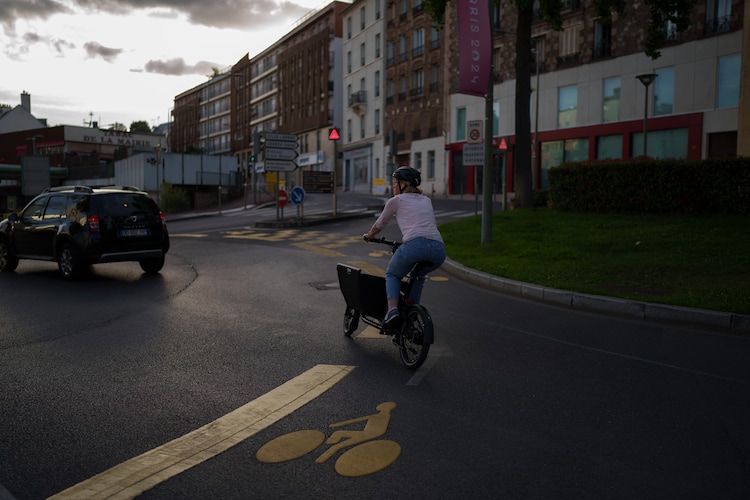Paris • BYU coach Ed Eyestone is not one for hyperbole. A cleareyed coach and two-time Olympian, he will casually describe his athletes’ 23-mile training runs in a way that makes it sound as if they had gone for brisk walks. He understands that hard training is a part of the profession and that marathons are inherently challenging, so why oversell the struggle?
But ask him about the marathon course at the Paris Olympics, and Eyestone speaks with a sort of reverence that borders on fear.
“This marathon,” he said, “will have a debris field in the final miles.”
Over the past two weeks, thousands of Olympians have tackled the seemingly impossible. Gymnasts have tumbled on 4-inch beams. Skateboarders have gone airborne over rails and ramps. Triathletes have submerged themselves in bacteria-infested waters.
But Paris 2024 organizers may have saved the most sadistic test for last.

(Chang W. Lee | The New York Times) A hilly stretch of the marathon course for the Paris 2024 Summer Olympics, on Aug. 7, 2024. From steep climbs to quad-crushing downhills, competitors in Paris face what is almost certainly the most difficult marathon course in the history of the Games.
Over 26.2 grueling miles this weekend, Olympic marathoners will be forced to contend with a series of steep climbs and quad-crushing downhills that comprise what is almost certainly the most difficult marathon course in the history of the Games.
The challenge, as always, is the pursuit of glory.
The true goal, more likely, will be survival.
“Oh, my gosh,” Canadian marathoner Malindi Elmore recalled telling her husband when she got her first look at the course in February, “this looks ridiculous.”
Both races, per tradition, will help bring down the curtain at the Games. The men will gather on the start line at Hôtel de Ville on Saturday. The women will race Sunday, hours before the closing ceremony. But after several weeks in Paris, all will set off knowing that a punishing two-plus-hour torture test awaits.
Long before he was able to see the course in person, Dathan Ritzenhein got a sneak peek. Several employees from the apparel brand On, which sponsors Ritzenhein’s running team, sent him video of the course’s inclines last year.
“It doesn’t look like you’d run up that,” Ritzenhein recalled telling them when he watched the clips. “It’s just comical.”
Ritzenhein coaches Hellen Obiri, a Kenyan who has shown her mettle on hills as the reigning back-to-back champion of the Boston Marathon. But the Paris course is a different beast, and Ritzenhein made sure to familiarize himself with it when he visited the city in July. He tied up his running sneakers and took to the streets so that he could experience the grueling heart of the course, from Mile 9 to Mile 23.
(Chang W. Lee | The New York Times) The Rue de Versailles, west of Paris, a hilly stretch of the marathon course for the 2024 Summer Olympics, on Aug. 7, 2024. From steep climbs to quad-crushing downhills, competitors in Paris face what is almost certainly the most difficult marathon course in the history of the Games.
“It’s really hard to imagine how extreme the course is without running it,” he said. “The course is unlike any major marathon these athletes have ever run.”
Olympic organizers have been curiously understated in their own assessments, describing the course in promotional materials as one that “will set demanding conditions for the athletes, because the Paris region is not as flat as it may seem.”
But the people most responsible for its treachery are long gone.
The first half of the course, which heads west toward Versailles, approximates the route taken by thousands of women, early in the French Revolution, who were seeking liberal reforms and sought to confront King Louis XVI at his palace.
The marathon course is a loop. After reaching Versailles, it winds its way back along the left bank of the Seine toward Paris and a finish at the Esplanade des Invalides, a 17th-century hospital that will, all these years later, welcome a fresh stream of broken bodies.
Because the course has hills. Long hills. Hard hills.
The first one is just before the 10-mile mark. Its 4% incline, according to Runner’s World, is the same as that of a stretch of the Boston Marathon that includes the notorious Heartbreak Hill. The difference is that the segment in Paris, at about 1.25 miles, is over twice as long as the one in Boston. The course should claim its first victims there.
The second hill is at around Mile 12, and slightly steeper at 5% but only about a half-mile long. No sweat, right? Wrong. The first two hills are mere hors d’oeuvres.
Around Mile 18, the race goes from difficult to extreme. The athletes will be deep enough into their mornings that any sort of undulation could cause problems, and Paris has a doozy: another ascent that maxes out at 13.5%.
“That hill,” American Conner Mantz said, “is going to be a big determinant of the race.”
(Chang W. Lee | The New York Times) The Rue de Ville d'Avray, west of Paris, a hilly stretch of the marathon course for the 2024 Summer Olympics, on Aug. 7, 2024. From steep climbs to quad-crushing downhills, competitors in Paris face what is almost certainly the most difficult marathon course in the history of the Games.
The twist is that after scaling that hill, the runners will almost immediately be running downhill — and at a sharp angle, which could strain their already tired legs.
One of the challenges in training, Eyestone said, is that running downhill at steep grades can lead to injury. Based on her own research, Elmore concluded that she needed to incorporate downhill running in her training only once every three or four weeks to reap the benefits.
Overall, she said, patience will be essential for the medal contenders — and everyone else.
“You just have to realize that you’re going to be running slower,” said Elmore, who placed ninth in the women’s marathon in hot conditions at the Tokyo Olympics in 2021. “You can’t rely on pace as your feedback during a race.”
In other words, throw away the idea of running consistent mile splits or finishing in a time that comes anywhere near your personal best. That is not going to happen this weekend.
This article originally appeared in The New York Times.







